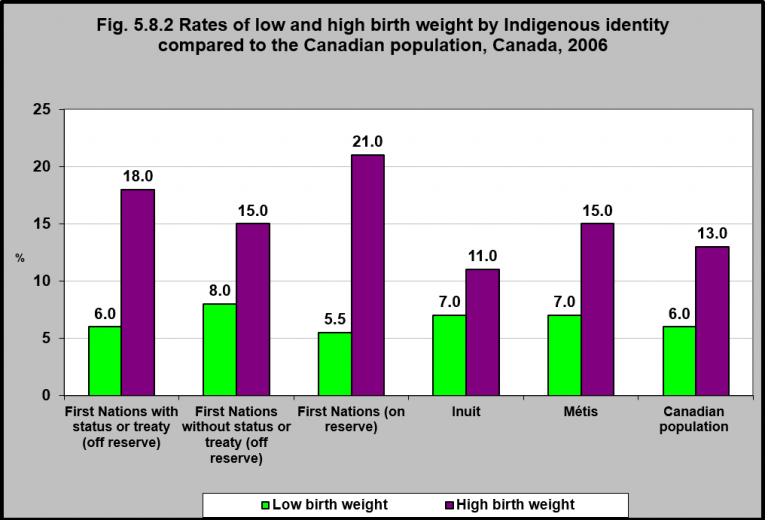Rates of low and high birth weight by Indigenous identity compared to the Canadian population, Canada, 2006

Notes:
Low birth weight: 0.4kg – 2.5kg
Average birth weight: 2.51kg – 4.0kg
High birth weight: >4.0kg
Source: CICH graphic created using data from Crengle,S., Freemantle, J., Gallaher, G., McAullay, D., McShane, K., & Taualii, M. (2009). Indigenous Children’s Health Report: Health Assessment in Action. Edited by Janet Smylie and Paul Adomako reference data from Aboriginal Children’s Survey, 2006; Regional Health Survey 2002/2003; National Longitudinal Survey of Children and Youth 2000/2001. http://caid.ca/IndChiHeaRep2009.pdf -accessed August 2, 2017.
In 2006, First Nations living off reserve with and without registered Indian status (18% and 15% respectively), First Nations living on reserve (21%) and Métis (15%) mothers had babies of higher birth weight compared to the Canadian population (13%). The rate for Inuit mothers was slightly less at 11%.
For low birth weight, the rate for the Canadian population was 6%. All Indigenous groups had higher low birth weight rates except First Nations on reserve who had a slightly lower rate at 5.5%. First Nations on reserve mothers also had the highest high birth weight rate at 21%.
Implications
Babies who are born with high or low birth weight are at increased risk of adverse health outcomes in childhood and later in life. Babies born with low birth weight are more likely to have wheezing disorders in childhood, be overweight or obese in adulthood, have coronary heart disease, lower levels of intelligence in adolescence, all-cause mortality, and chronic kidney disease compared to normal weight babies.1 High birth weight babies are often called large for gestational age (LGA). They may be large because their parents are large and have passed this trait along to their children, because of the weight gained by a mother during pregnancy, or because the mother has high blood sugar which can be passed along to her baby.2 Babies who are LGA are at greater risk of immediate health issues such as low blood sugar immediately after birth, birth defects, trouble breathing, and injuries sustained through birth, and jaundice. They are also at higher risk of long term health issues such as higher death rates from certain cancers, obesity and type II diabetes mellitus.1
1Belbasis, L., Savvidou, M.D., Kanu, C., Evangelou, E., & Tzoulaki, I. (2016). Birth weight in relation to health and disease in later life: An umbrella review of systematic reviews and meta-analyses. BMC Medicine, 14, 147.
2University of Rochester Medical Center. (2017). Large for gestational age. Adult and children’s health encyclopedia. https://www.urmc.rochester.edu/encyclopedia/content.aspx?ContentTypeID=90&ContentID=P02383 -accessed October 7, 2017.
